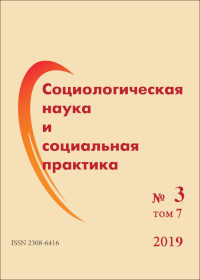Muslim Migrants in Germany: Problems of Adaptation and Integration
Abstract
References
Sarratsin T. Germaniya: samolikvidatsiya. [Germany: self-destruct]. M.: AST publ., 2016. 560 p. (In Russ.).
Becher I., El-Menouar Y. Geschlechterrollen bei Deutschen und Zuwanderern christlicher und muslimischer Religionszugehörigkeit. Bundesamt für Migration und Flüchtlinge, 2014.
Das Bundesamt in Zahlen 2015. Asyl, Migration und Integration. Bundesamt für Migration und Flüchtlinge, 2016.
Das Bundesamt in Zahlen 2016. Asyl, Migration und Integration. Bundesamt für Migration und Flüchtlinge, 2017.
Das Bundesamt in Zahlen 2017. Asyl, Migration und Integration. Bundesamt für Migration und Flüchtlinge, 2018.
Das Bundesamt in Zahlen 2018. Asyl. Bundesamt für Migration und Flüchtlinge, 2019.
Esser H. Integration und ethnische Schichtung. Arbeitspapiere – Mannheimer Zentrum für Europäische Sozialforschung № 40, 2001.
Heug S., Müssig St., Stichs A. Muslimisches Leben in Deutschland. Bundesamt für Migration und Flüchtlinge, 2009.
Migrationsbericht 2015. Zentrale Ergebnisse. Bundesamt fur Migration und Fluchtlinge, 2016.
Nach der Flucht: Der Weg in die Arbeit – Arbeitsmarktintegration von Flüchtlingen in Deutschland. OECD, 2017. 64 р.
Schührer S. Türkeistämmige Personen in Deutschland. Bundesamt für Migration und Flüchtlinge, 2018. 81 р.
Siegert M. Die sozialen Kontakte Geflüchteter. Ausgabe 04|2019 der urzanalysen des Forschungszentrums Migration, Integration und Asyl des Bundesamtes für Migration und Flüchtlinge, Nürnberg. 2019. 12 p.
Stichs A. Wie viele Muslime leben in Deutschland? Bundesamt für Migration und Flüchtlinge, 2018.
Worbs S., Baraulina T. Geflüchtete Frauen in Deutschland: Sprache, Bildung und Arbeitsmarkt. Ausgabe 1|2017 der Kurzanalysen des Forschungszentrums. Migration, Integration und Asyl des Bundesamtes für Migration und Flüchtlinge, Nürnberg, 2017. 14 p.
Weichselbaumer D. Discrimination against Female Migrants Wearing Headscarves, IZA Discussion Paper Nr. 10217, Bonn: IZA – Forschungsinstitut zur Zukunft der Arbeit, 2016.








 Publisher: Federal Center of Theoretical and Applied Sociology of the Russian Academy of Sciences (FCTAS RAS)
Publisher: Federal Center of Theoretical and Applied Sociology of the Russian Academy of Sciences (FCTAS RAS)